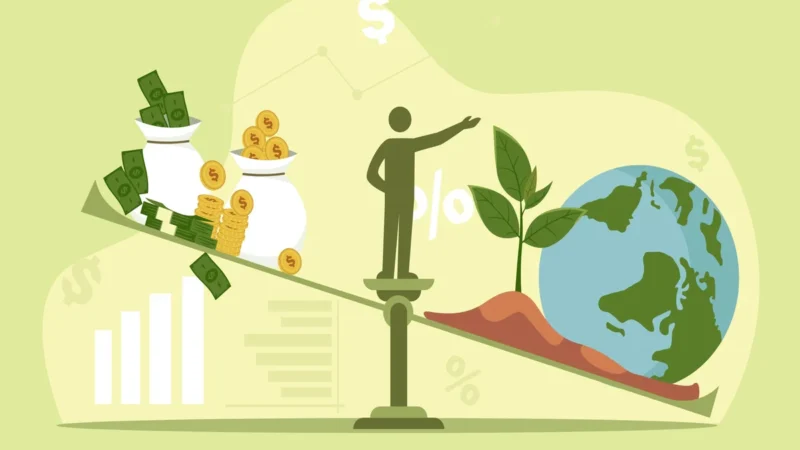Towards Sustainability: Promoting the Circular Economy and Resource Efficiency

In an era marked by growing environmental concerns and resource scarcity, the concept of the circular economy has emerged as a beacon of hope. By shifting away from the traditional linear “take-make-dispose” model, the circular economy aims to create a regenerative system where resources are continuously reused, recycled, and repurposed. This article delves into the significance of promoting the circular economy as a key strategy for achieving sustainability and enhancing resource efficiency.
1.The Circular Economy Approach
The circular economy stands in stark contrast to the prevailing linear economy, which contributes significantly to resource depletion and environmental degradation. In a circular economy, products and materials are designed to have extended lifecycles, and their components can be easily disassembled, repaired, and repurposed. This shift emphasizes reducing waste and conserving resources, while also addressing the challenges posed by our current unsustainable consumption patterns.
2.Resource Conservation through Loop Closure
One of the core principles of the circular economy is the concept of “closing the loop.” This involves keeping resources within the economic system for as long as possible, thereby minimizing the need for new resource extraction. By encouraging practices such as recycling, remanufacturing, and refurbishment, we can significantly reduce the demand for raw materials and lower the energy consumption associated with extraction and production.
3.Economic and Environmental Benefits
The adoption of circular economy practices brings forth a multitude of benefits. Economically, it fosters innovation, as businesses need to rethink their product design, manufacturing processes, and business models. By embracing resource-efficient practices, companies can also reduce operational costs and gain a competitive edge. Environmentally, the circular economy helps decrease pollution, greenhouse gas emissions, and the overall ecological footprint.
4.Challenges and Transition
Transitioning to a circular economy is not without its challenges. The shift requires collaboration among various stakeholders, including governments, businesses, and consumers. It demands a shift in mindset and the adoption of new technologies. Moreover, creating effective collection and recycling systems, addressing legal and regulatory barriers, and overcoming consumer behavior inertia are critical aspects of successful circular economy implementation.
5.Realizing the Circular Vision
Several companies and regions have already made strides in embracing circular economy principles. For instance, the city of Amsterdam in the Netherlands has implemented policies to encourage circular practices, resulting in reduced waste and increased resource efficiency. Companies like Patagonia and Philips have integrated circularity into their business models, from product design to take-back programs, demonstrating the feasibility and benefits of a circular approach.
we can conclude this, the journey towards sustainability requires a profound transformation in how we produce, consume, and manage resources. The circular economy offers a roadmap for achieving this transformation by promoting resource efficiency, reducing waste, and minimizing environmental impact. As we continue to witness the depletion of finite resources and the degradation of ecosystems, embracing the circular economy becomes not just an option, but a necessity for a more sustainable future.
FAQ
1.What is the circular economy, and how does it differ from the traditional linear economy?
The circular economy is a new way of thinking about how we use resources. Unlike the linear economy, where products are made, used, and then discarded as waste, the circular economy aims to keep resources in use for as long as possible. This means designing products to last, repairing and reusing items, and recycling materials to create a continuous cycle of resource conservation.
2.How does the circular economy benefit the environment and our daily lives?
Embracing the circular economy has a positive impact on both the environment and our daily lives. By reducing waste and using resources more efficiently, we can lower pollution, decrease energy consumption, and cut down on greenhouse gas emissions. Additionally, circular practices can lead to more durable and higher-quality products, saving us money in the long run and creating a healthier planet for future generations.
3.What role can businesses and industries play in promoting the circular economy?
Businesses and industries play a crucial role in driving the circular economy forward. They can design products with durability and repairability in mind, adopt recycling and remanufacturing processes, and explore new business models like product-as-a-service. By making these changes, companies can not only contribute to sustainability but also find innovative ways to reduce costs and attract environmentally-conscious consumers.
4.How can individuals contribute to the circular economy in their everyday lives?
Individuals can make a big difference in promoting the circular economy through their daily choices. This includes buying products with longer lifespans, repairing items instead of discarding them, recycling properly, and supporting businesses that prioritize sustainability. By being mindful of our consumption habits and making eco-friendly decisions, we can collectively drive the shift towards a circular and resource-efficient future.
5.What are some inspiring examples of circular economy practices in action?
There are many inspiring examples of circular economy practices happening around the world. For instance, some fashion brands offer clothing rental services to reduce clothing waste. Tech companies are designing smartphones with modular components for easier repair and upgrade. Cities are implementing effective recycling and waste separation programs to maximize resource recovery. These real-world examples showcase the potential and benefits of circular thinking in various industries and aspects of our lives.


